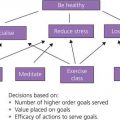Art does not reproduce the visible, but makes visible.
Paul Klee
Introduction
Concepts and techniques which belong to the world of art are not obvious even in medical practice. They may hurt certain aspects of the medical identity. But having experienced this unique help which the arts can offer to the quality of long-term care, physicians and other health professionals (HPs) are discovering a new dimension in their profession.
Medical identity
Doctors are trained to diagnose: and analysis what is not functioning in the human body. They act like an accountant trained to evaluate the pluses and minuses of a budget. Their role is to scan the excess expenditure, find errors in management and suggest solutions.
The same is true for HP at the time of diagnosis, in particular for emergencies. But with chronic diseases the HPs have also to accompany their patient over time. In this situation they have to adopt quite a different role. They need new skills to deal with the psychological suffering of patients in order to help them to express their difficulties in coping, doubts about healing, beliefs about the efficacy and the cost of treatment. Helping a person express their feelings is a major responsibility for all HPs involved in the accompaniment of patients suffering from chronic diseases.
Artists are accustomed to expressing and illustrating sorrow, doubts, joy, anxiety, loneliness, depression and the fear of death. The arts offer people a testimony to man’s condition. Since suffering is normally endured in silence, the arts represent a unique way for people to exchange and express feelings in a metaphoric way through music, painting, writing and theatre.
The four cardinal axes of healthcare delivery
Healthcare delivery is quite a complex activity particularly for those who have to treat and accompany patients suffering from chronic diseases for several years. According to the World Health Organisation (WHO), more than 100 different diseases are listed as chronic diseases, i.e. diseases that cannot be cured but can be treated effectively if patients have been taught how to manage their own treatment. The term ‘patient education’ has, therefore, been replaced by Therapeutic Patient Education (TPE) in order to stress that this type of education is directly linked to its effect on the management of the disease and should be provided by HPs: doctors, nurses, nutritionists, and psychologists.
Four dimensions should be mentioned. They are medical, psychological, educational and the accompaniment dimensions. In healthcare delivery, these are constantly linked together. In integrated care none of them is ever independent from the others. It is important to grasp that there is a permanent gap between patients and caregivers. One is looking for help, the other is an “expert” at establishing diagnoses and providing the appropriate care. Great effort is made to develop a more equal relationship between both partners but there is always an imbalance between the expectations of the patient and the expertise of the caregiver.
A fundamental characteristic of chronic diseases is their duration, and the obligation of caregivers to accompany the same patient for many months or years. This situation carries risks: monotony, weariness and even burnout of all involved—the patient and their family, and all the members of the healthcare team. This is where creativity offers a unique source of renewal. Creativity offers a neutral space where the patient does not have to justify their expectations and where the caregiver may leave off their professional identity for a brief period. Both may express, through the medium of painting, theatre, music and dance, personal experiences that they may never have talked about and which may be important for their identity and the quality of their subsequent treatment.
The disease
The basics of medical education imply knowing the causes of diseases, the diagnostic procedures and the appropriate therapeutic measures to initiate. It is an important mass of theoretical knowledge and of practical experience to master. Medical activity is often bound up with an emergency. Often the very first activities of HPs are subject to the dimension of urgency. Professional identity is often shaped by first medical experiences where the patient is thankful because their pain has disappeared and that HPs know how to cure the disease.
However, more than 85% of medical visits concern chronic conditions where HPs have to change their focus from an emergency situation to a person suffering. How is the patient coping with the difficulty of not being cured? This situation requires HPs to change their approach radically and accept without frustration to accompany their patient rather than necessarily to cure him.
Understanding the clinical relationship between an HP and the patient
How many patients have been shocked by the way the diagnosis was given to them, or how little the HP realises the effects they have on their patient. Medical responsibility in biomedicine depends on rigorous diagnostic procedures and precise therapeutic choices. But medical responsibility is also a human responsibility that includes respect and solicitude towards the patient. Dealing with a chronically ill patient requires the HP to spare sufficient time to create a trustful relationship where concern is given to the way the patient copes with his disease and his illness. In this perspective, the patient becomes the subject and not the object of the concern and activity of the HP.
The therapeutic education of the patient and their family
I remember a patient who thanked me because I ‘cured’ him. He had diabetes and had been on insulin for 30 years. I could not understand what he meant since this type of diabetes is a lifelong condition. But this patient had intuitively sensed the role and effect of therapeutic education. Thanks to the process of education, he gradually experienced how he could manage his treatment and adapt it to his various daily activities. His success in this respect illustrates the profound effects of therapeutic education: to allow the patient to feel in control of his diabetes. He was cured of the blind passive dependence on his doctor. He discovered his own power in managing his diabetes.
The accompaniment of the patient over months and years
Solitude, loss of self-esteem and difficulty in making plans is found in almost all patients suffering from a chronic disease. One may define the chronic patient as the bearer of a heavy psychological load that they carry in silence day-after-day.
Suffering is rarely openly expressed, and if clinicians are not aware of it, it is often detected too late. Creativity and artistic expression may be a unique opportunity to help patients express their psychological reactions to their disease and help HPs to understand more about their patient and to be closer to them.
Listening to patients and modes of self-expression
There is an urgent need to promote activities where carers and patients can share some of their life experiences. There are various ways of doing this:
- Active listening
- Patient narratives about signs and symptoms of the disease and/or illness, their daily family, professional and social lives
- Painting workshops as a developmental process stimulating self-expression
- The theatre of lived experience, an opening up of the psychosocial dimension of each individual.
Promoting creativity
The direct description of true, real suffering is almost impossible. First because pain is an eminently personal experience and its direct verbal description may not be sensed correctly by the person to whom the victim addresses the description. Using the metaphor of the brightness of the sun, we cannot describe its strength in simple words. But poets can, as well as actors, artists and musicians.
The 10 year experience at our foundation has shown that an artist is hidden in each individual, even in the most sceptical. Through painting, writing, theatre and dance personal experiences can be expressed, irrespective of the cultural origin and the social background of the individual.
Painting as a process of transformation
The purpose of this chapter is to describe the structure of painting workshops and the specific benefits the participants acquire through their experience of painting. Painting workshops for people suffering from chronic conditions opened in Geneva (Switzerland) in 2004, sponsored by the Foundation for Research and training in Patient Education. At the time of writing, 50 painting workshops have been organised and 90 people have participated. In order to better understand the ability of painting to play a role in the healing process, we have looked at how artists themselves explain their own experience of painting and the painting process in general.
Structure of the painting workshop
Each painting workshop, conceived as a unit, lasts two and a half days and takes place once a month. The participants are adults suffering from a chronic condition: diabetes, obesity, anorexia, cancer, alcoholism, leg amputation or recurring depression. Groups may be heterogeneous regarding age, sex, motivation, artistic training and medical conditions or, on request, the workshop brings together homogeneous groups and focuses on specific goals.
The mean age is 50. The participants do not need to have previous experience or skill in art. The workshop size is limited to eight participants. They can arrange their particular programme following their needs: they can choose the time and frequency of sessions, the artist and the group. They can attend painting workshops as many times as they wish. Many people come on a regular basis and intensify the frequency in periods of stress. The average attendance is five times.
The teacher is a professional painter, not an art-therapist. The artist knows by experience the steps leading to creation and has a deep expertise of artistic techniques which allows them to guide the participant away from stereotypes, thus encouraging the emergence of a personal style. Artists are inclined to push the participants to experiment, to explore, to go beyond their limits and to clarify what they really want to express.
At the end of each session there is a round-table discussion of all the paintings produced. The group listens to the stories behind the paintings as told by each participant, sharing experiences and emotions. Verbalising the experience lived through helps participants understand themselves better as well as share the experience with others. ‘The affective dimension of the group allowed me to feel connected again with a social life’ one participant said. The heterogeneity of the group is positive: the confrontation of differences stimulates interaction and questioning about other ways of perceiving and thinking. During this round-table discussion, a group moderator favours interactions, regulates confrontations and collects data in order to evaluate the efficacy of the work done.
Results
Attending one or several workshops, the participants undergo beneficial changes in their attitudes to their condition. Let us look at three cases to see how the process of creation helped a particular individual to come to terms with their condition.
The process of creation as it has been explained by some professional painters:
The process of creation, which these three people went through, had its therapeutic effect because of the specific characteristics of the creative dynamic itself. Let us look at how various painters described it. We will see that the testimonies of our workshop participants are full of echoes of what the artists say.
Creation involves introspection
Matisse said every authentic effort of creation was interior (Henri Matisse 1949 in Fourcade 1992, p. 322) suggested painting has its roots in memory, more than in visual perception. Immersed in his inner world, the painter encounters and awakens old feelings and memories that have been denied or repressed and in letting them emerge he is confronted with himself. He discovers himself (Fabienne Verdier, in Charles Juillet 2007, p. 33).
Stay updated, free articles. Join our Telegram channel

Full access? Get Clinical Tree






